2012 FORD FOCUS ELECTRIC seats
[x] Cancel search: seatsPage 200 of 380
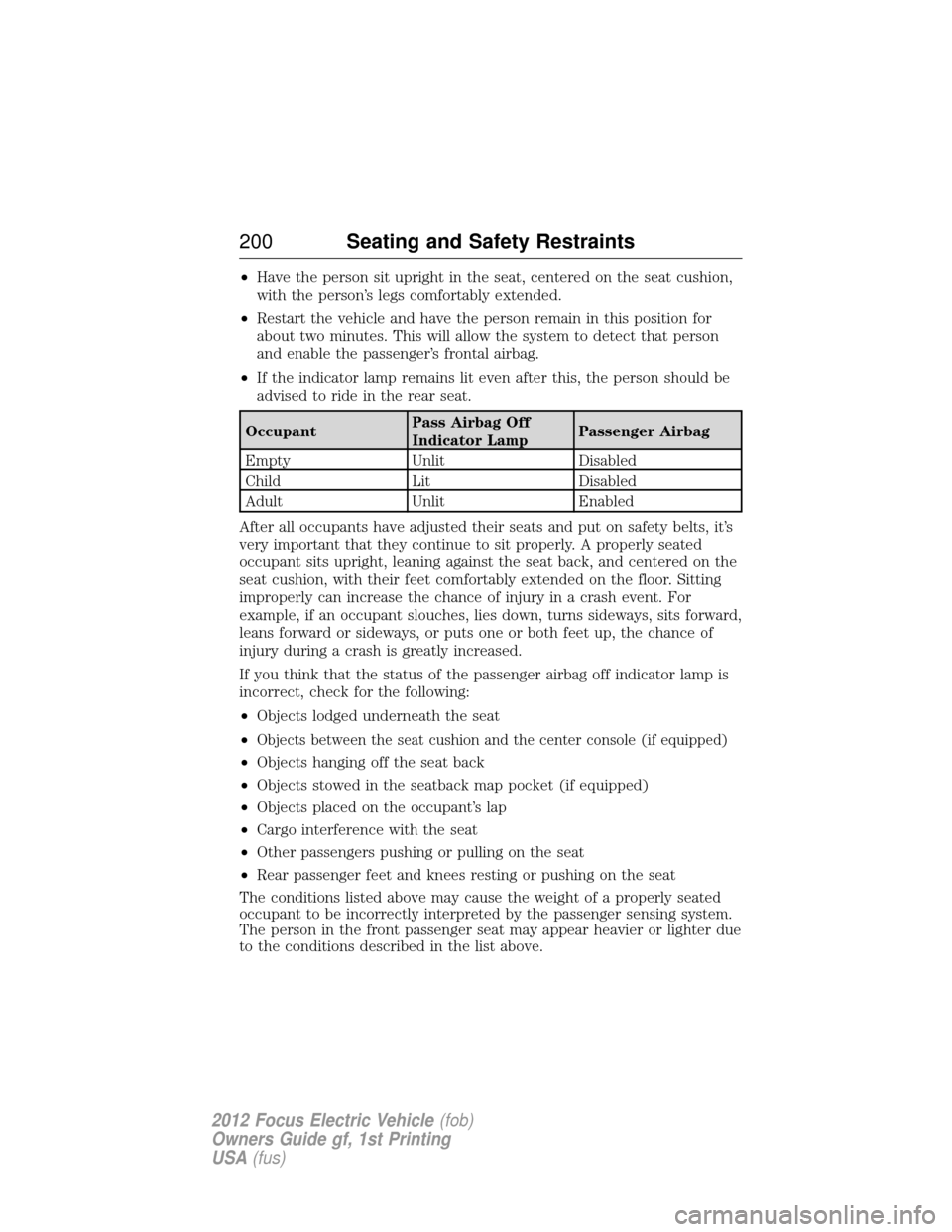
•Have the person sit upright in the seat, centered on the seat cushion,
with the person’s legs comfortably extended.
• Restart the vehicle and have the person remain in this position for
about two minutes. This will allow the system to detect that person
and enable the passenger’s frontal airbag.
• If the indicator lamp remains lit even after this, the person should be
advised to ride in the rear seat.
Occupant Pass Airbag Off
Indicator LampPassenger Airbag
Empty UnlitDisabled
Child LitDisabled
Adult UnlitEnabled
After all occupants have adjusted their seats and put on safety belts, it’s
very important that they continue to sit properly. A properly seated
occupant sits upright, leaning against the seat back, and centered on the
seat cushion, with their feet comfortably extended on the floor. Sitting
improperly can increase the chance of injury in a crash event. For
example, if an occupant slouches, lies down, turns sideways, sits forward,
leans forward or sideways, or puts one or both feet up, the chance of
injury during a crash is greatly increased.
If you think that the status of the passenger airbag off indicator lamp is
incorrect, check for the following:
• Objects lodged underneath the seat
•
Objects between the seat cushion and the center console (if equipped)
• Objects hanging off the seat back
• Objects stowed in the seatback map pocket (if equipped)
• Objects placed on the occupant’s lap
• Cargo interference with the seat
• Other passengers pushing or pulling on the seat
• Rear passenger feet and knees resting or pushing on the seat
The conditions listed above may cause the weight of a properly seated
occupant to be incorrectly interpreted by the passenger sensing system.
The person in the front passenger seat may appear heavier or lighter due
to the conditions described in the list above.
200 Seating and Safety Restraints
2012 Focus Electric Vehicle (fob)
Owners Guide gf, 1st Printing
USA (fus)
Page 202 of 380
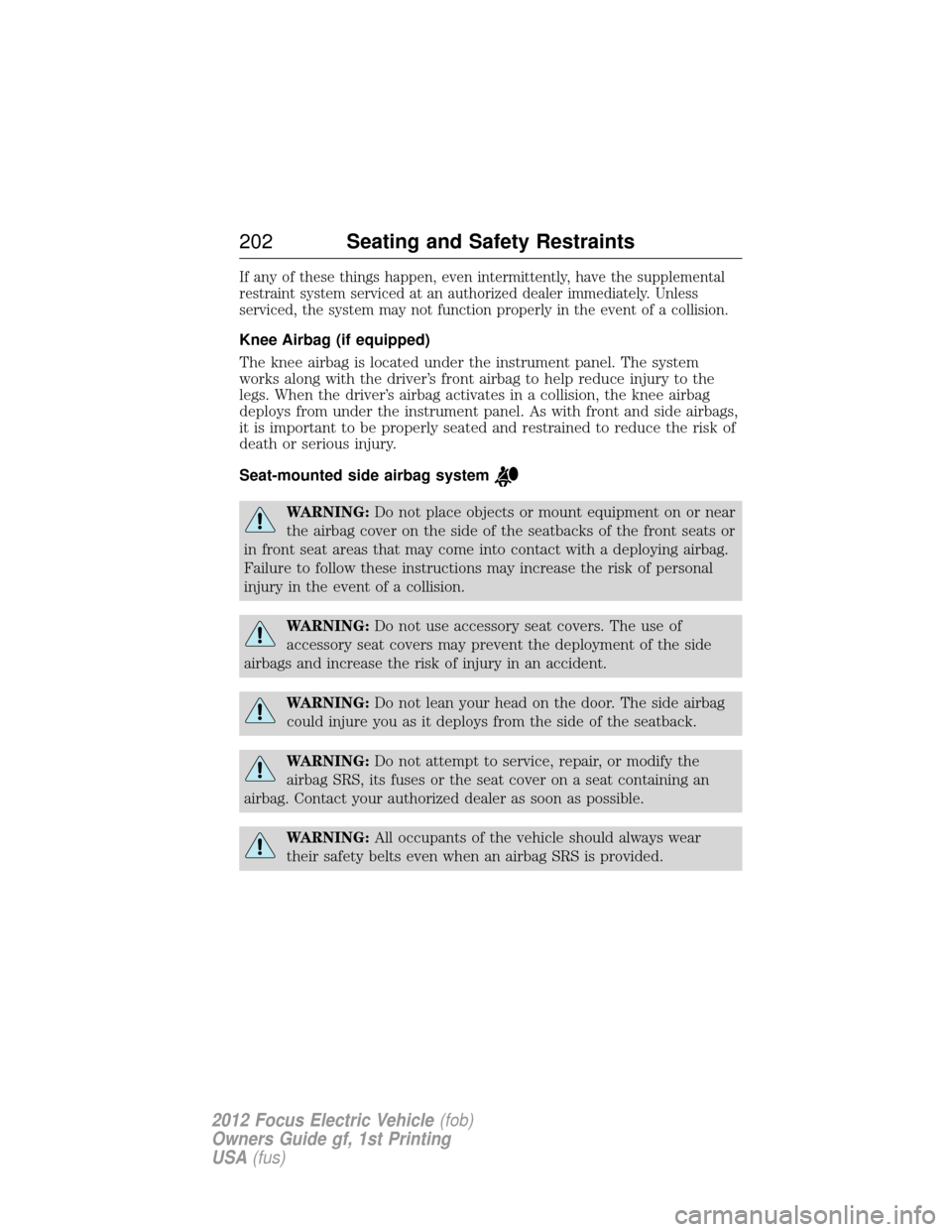
If any of these things happen, even intermittently, have the supplemental
restraint system serviced at an authorized dealer immediately. Unless
serviced, the system may not function properly in the event of a collision.
Knee Airbag (if equipped)
The knee airbag is located under the instrument panel. The system
works along with the driver’s front airbag to help reduce injury to the
legs. When the driver’s airbag activates in a collision, the knee airbag
deploys from under the instrument panel. As with front and side airbags,
it is important to be properly seated and restrained to reduce the risk of
death or serious injury.
Seat-mounted side airbag system
WARNING:Do not place objects or mount equipment on or near
the airbag cover on the side of the seatbacks of the front seats or
in front seat areas that may come into contact with a deploying airbag.
Failure to follow these instructions may increase the risk of personal
injury in the event of a collision.
WARNING: Do not use accessory seat covers. The use of
accessory seat covers may prevent the deployment of the side
airbags and increase the risk of injury in an accident.
WARNING: Do not lean your head on the door. The side airbag
could injure you as it deploys from the side of the seatback.
WARNING: Do not attempt to service, repair, or modify the
airbag SRS, its fuses or the seat cover on a seat containing an
airbag. Contact your authorized dealer as soon as possible.
WARNING: All occupants of the vehicle should always wear
their safety belts even when an airbag SRS is provided.
202 Seating and Safety Restraints
2012 Focus Electric Vehicle (fob)
Owners Guide gf, 1st Printing
USA (fus)
Page 203 of 380
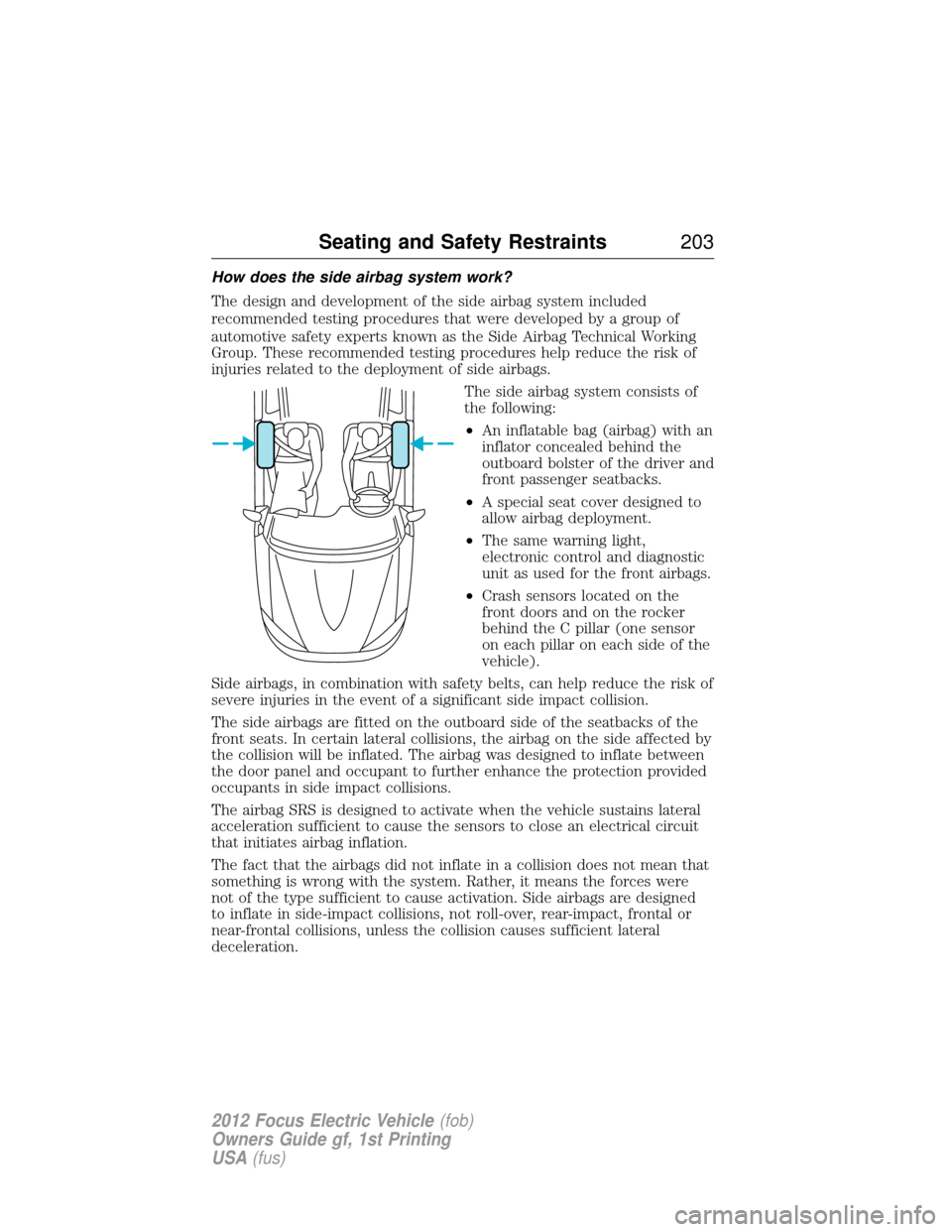
How does the side airbag system work?
The design and development of the side airbag system included
recommended testing procedures that were developed by a group of
automotive safety experts known as the Side Airbag Technical Working
Group. These recommended testing procedures help reduce the risk of
injuries related to the deployment of side airbags.The side airbag system consists of
the following:
•An inflatable bag (airbag) with an
inflator concealed behind the
outboard bolster of the driver and
front passenger seatbacks.
• A special seat cover designed to
allow airbag deployment.
• The same warning light,
electronic control and diagnostic
unit as used for the front airbags.
• Crash sensors located on the
front doors and on the rocker
behind the C pillar (one sensor
on each pillar on each side of the
vehicle).
Side airbags, in combination with safety belts, can help reduce the risk of
severe injuries in the event of a significant side impact collision.
The side airbags are fitted on the outboard side of the seatbacks of the
front seats. In certain lateral collisions, the airbag on the side affected by
the collision will be inflated. The airbag was designed to inflate between
the door panel and occupant to further enhance the protection provided
occupants in side impact collisions.
The airbag SRS is designed to activate when the vehicle sustains lateral
acceleration sufficient to cause the sensors to close an electrical circuit
that initiates airbag inflation.
The fact that the airbags did not inflate in a collision does not mean that
something is wrong with the system. Rather, it means the forces were
not of the type sufficient to cause activation. Side airbags are designed
to inflate in side-impact collisions, not roll-over, rear-impact, frontal or
near-frontal collisions, unless the collision causes sufficient lateral
deceleration.
Seating and Safety Restraints 203
2012 Focus Electric Vehicle(fob)
Owners Guide gf, 1st Printing
USA (fus)
Page 206 of 380
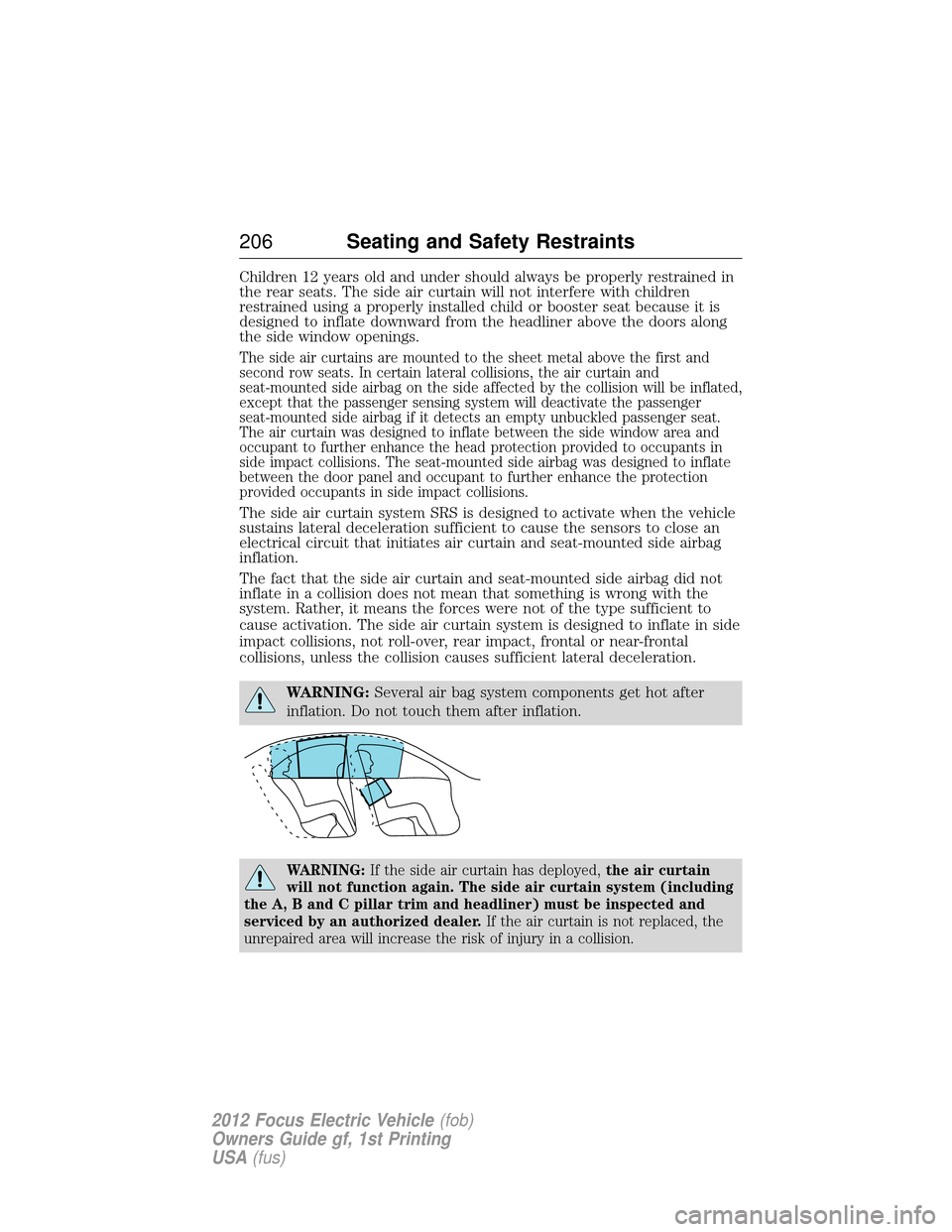
Children 12 years old and under should always be properly restrained in
the rear seats. The side air curtain will not interfere with children
restrained using a properly installed child or booster seat because it is
designed to inflate downward from the headliner above the doors along
the side window openings.
The side air curtains are mounted to the sheet metal above the first and
second row seats. In certain lateral collisions, the air curtain and
seat-mounted side airbag on the side affected by the collision will be inflated,
except that the passenger sensing system will deactivate the passenger
seat-mounted side airbag if it detects an empty unbuckled passenger seat.
The air curtain was designed to inflate between the side window area and
occupant to further enhance the head protection provided to occupants in
side impact collisions. The seat-mounted side airbag was designed to inflate
between the door panel and occupant to further enhance the protection
provided occupants in side impact collisions.
The side air curtain system SRS is designed to activate when the vehicle
sustains lateral deceleration sufficient to cause the sensors to close an
electrical circuit that initiates air curtain and seat-mounted side airbag
inflation.
The fact that the side air curtain and seat-mounted side airbag did not
inflate in a collision does not mean that something is wrong with the
system. Rather, it means the forces were not of the type sufficient to
cause activation. The side air curtain system is designed to inflate in side
impact collisions, not roll-over, rear impact, frontal or near-frontal
collisions, unless the collision causes sufficient lateral deceleration.
WARNING:Several air bag system components get hot after
inflation. Do not touch them after inflation.
WARNING: If the side air curtain has deployed, the air curtain
will not function again. The side air curtain system (including
the A, B and C pillar trim and headliner) must be inspected and
serviced by an authorized dealer. If the air curtain is not replaced, the
unrepaired area will increase the risk of injury in a collision.
206 Seating and Safety Restraints
2012 Focus Electric Vehicle (fob)
Owners Guide gf, 1st Printing
USA (fus)
Page 208 of 380
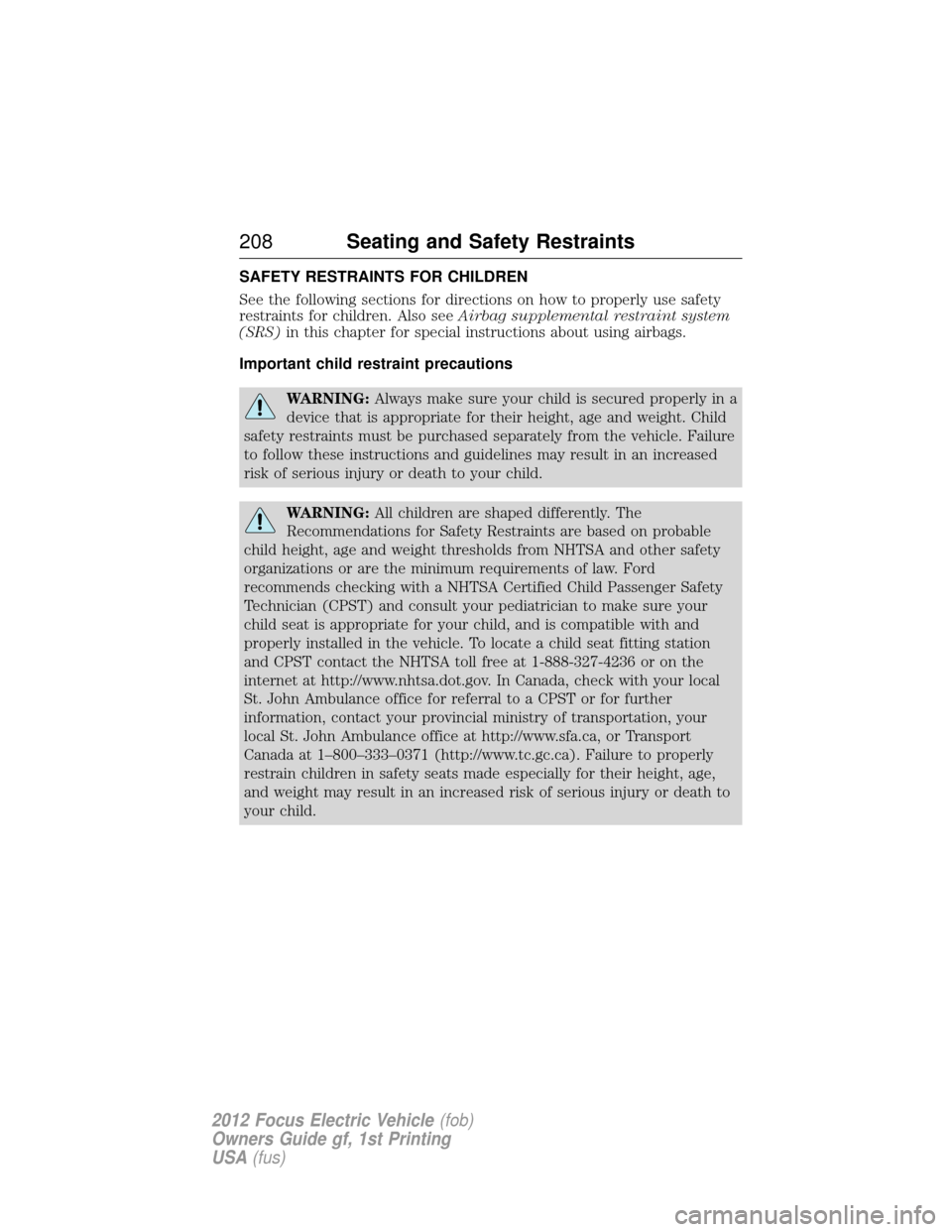
SAFETY RESTRAINTS FOR CHILDREN
See the following sections for directions on how to properly use safety
restraints for children. Also seeAirbag supplemental restraint system
(SRS) in this chapter for special instructions about using airbags.
Important child restraint precautions
WARNING: Always make sure your child is secured properly in a
device that is appropriate for their height, age and weight. Child
safety restraints must be purchased separately from the vehicle. Failure
to follow these instructions and guidelines may result in an increased
risk of serious injury or death to your child.
WARNING: All children are shaped differently. The
Recommendations for Safety Restraints are based on probable
child height, age and weight thresholds from NHTSA and other safety
organizations or are the minimum requirements of law. Ford
recommends checking with a NHTSA Certified Child Passenger Safety
Technician (CPST) and consult your pediatrician to make sure your
child seat is appropriate for your child, and is compatible with and
properly installed in the vehicle. To locate a child seat fitting station
and CPST contact the NHTSA toll free at 1-888-327-4236 or on the
internet at http://www.nhtsa.dot.gov. In Canada, check with your local
St. John Ambulance office for referral to a CPST or for further
information, contact your provincial ministry of transportation, your
local St. John Ambulance office at http://www.sfa.ca, or Transport
Canada at 1–800–333–0371 (http://www.tc.gc.ca). Failure to properly
restrain children in safety seats made especially for their height, age,
and weight may result in an increased risk of serious injury or death to
your child.
208 Seating and Safety Restraints
2012 Focus Electric Vehicle (fob)
Owners Guide gf, 1st Printing
USA (fus)
Page 209 of 380
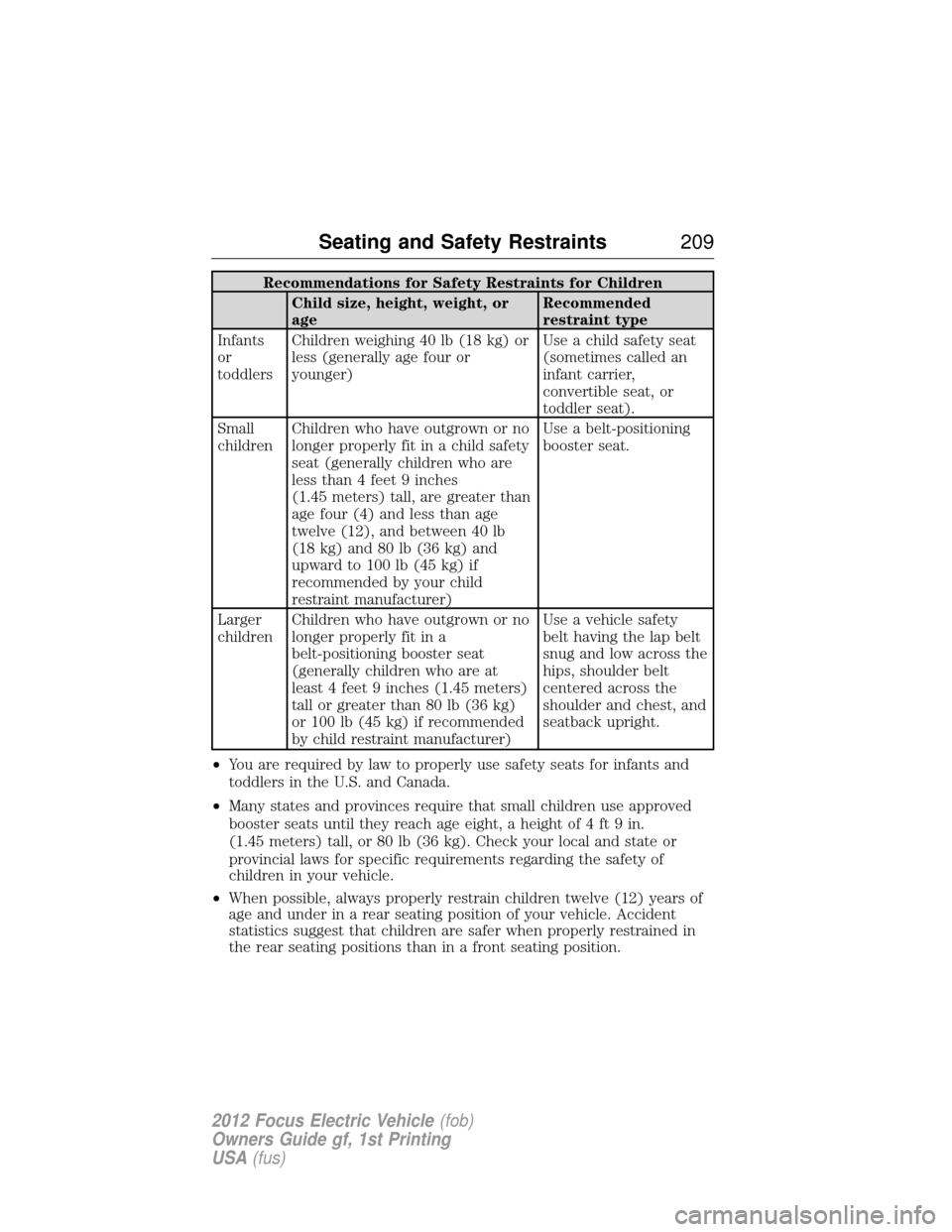
Recommendations for Safety Restraints for ChildrenChild size, height, weight, or
age Recommended
restraint type
Infants
or
toddlers Children weighing 40 lb (18 kg) or
less (generally age four or
younger) Use a child safety seat
(sometimes called an
infant carrier,
convertible seat, or
toddler seat).
Small
children Children who have outgrown or no
longer properly fit in a child safety
seat (generally children who are
less than 4 feet 9 inches
(1.45 meters) tall, are greater than
age four (4) and less than age
twelve (12), and between 40 lb
(18 kg) and 80 lb (36 kg) and
upward to 100 lb (45 kg) if
recommended by your child
restraint manufacturer) Use a belt-positioning
booster seat.
Larger
children Children who have outgrown or no
longer properly fit in a
belt-positioning booster seat
(generally children who are at
least 4 feet 9 inches (1.45 meters)
tall or greater than 80 lb (36 kg)
or 100 lb (45 kg) if recommended
by child restraint manufacturer) Use a vehicle safety
belt having the lap belt
snug and low across the
hips, shoulder belt
centered across the
shoulder and chest, and
seatback upright.
• You are required by law to properly use safety seats for infants and
toddlers in the U.S. and Canada.
• Many states and provinces require that small children use approved
booster seats until they reach age eight, a height of 4 ft 9 in.
(1.45 meters) tall, or 80 lb (36 kg). Check your local and state or
provincial laws for specific requirements regarding the safety of
children in your vehicle.
• When possible, always properly restrain children twelve (12) years of
age and under in a rear seating position of your vehicle. Accident
statistics suggest that children are safer when properly restrained in
the rear seating positions than in a front seating position.
Seating and Safety Restraints 209
2012 Focus Electric Vehicle(fob)
Owners Guide gf, 1st Printing
USA (fus)
Page 212 of 380
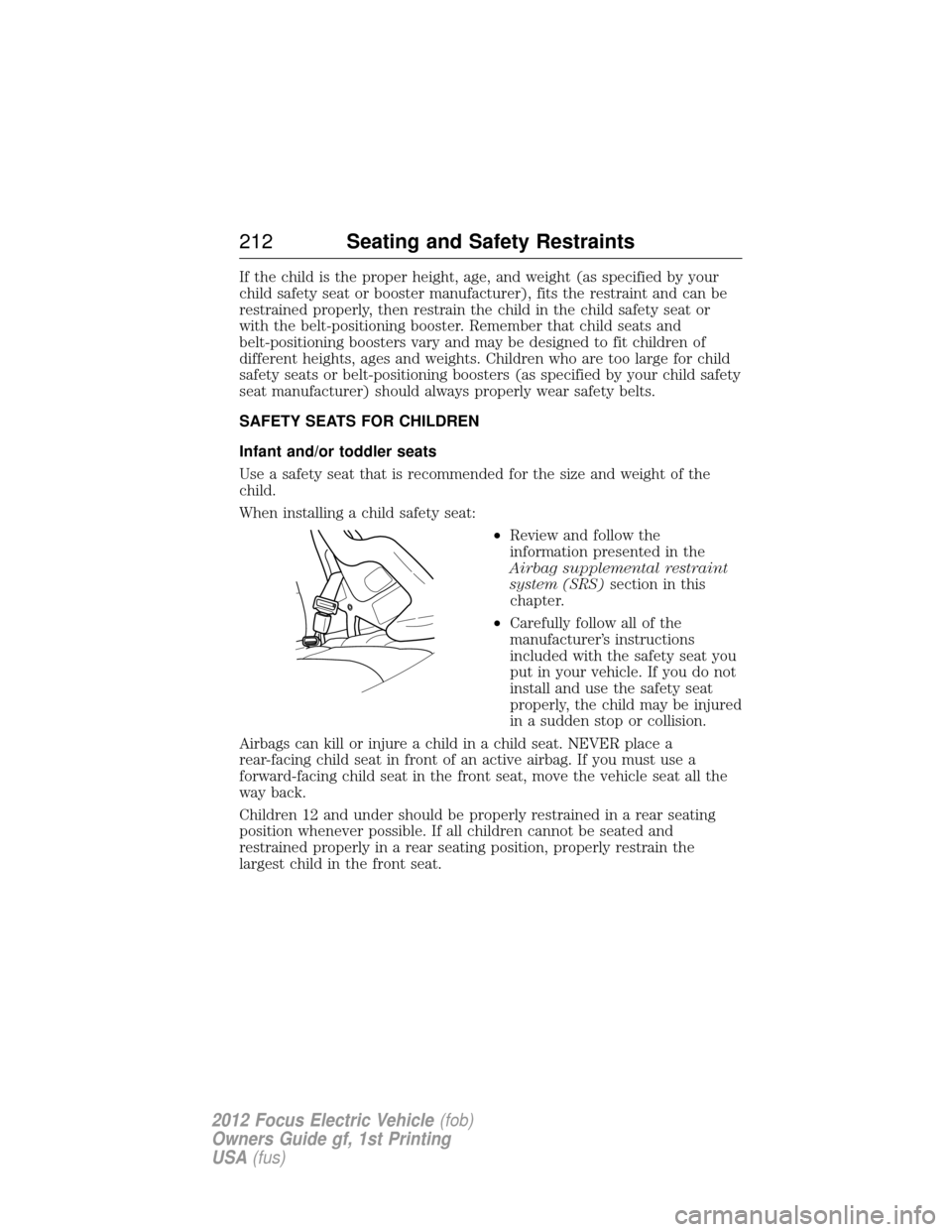
If the child is the proper height, age, and weight (as specified by your
child safety seat or booster manufacturer), fits the restraint and can be
restrained properly, then restrain the child in the child safety seat or
with the belt-positioning booster. Remember that child seats and
belt-positioning boosters vary and may be designed to fit children of
different heights, ages and weights. Children who are too large for child
safety seats or belt-positioning boosters (as specified by your child safety
seat manufacturer) should always properly wear safety belts.
SAFETY SEATS FOR CHILDREN
Infant and/or toddler seats
Use a safety seat that is recommended for the size and weight of the
child.
When installing a child safety seat:•Review and follow the
information presented in the
Airbag supplemental restraint
system (SRS) section in this
chapter.
• Carefully follow all of the
manufacturer’s instructions
included with the safety seat you
put in your vehicle. If you do not
install and use the safety seat
properly, the child may be injured
in a sudden stop or collision.
Airbags can kill or injure a child in a child seat. NEVER place a
rear-facing child seat in front of an active airbag. If you must use a
forward-facing child seat in the front seat, move the vehicle seat all the
way back.
Children 12 and under should be properly restrained in a rear seating
position whenever possible. If all children cannot be seated and
restrained properly in a rear seating position, properly restrain the
largest child in the front seat.
212 Seating and Safety Restraints
2012 Focus Electric Vehicle (fob)
Owners Guide gf, 1st Printing
USA (fus)
Page 213 of 380
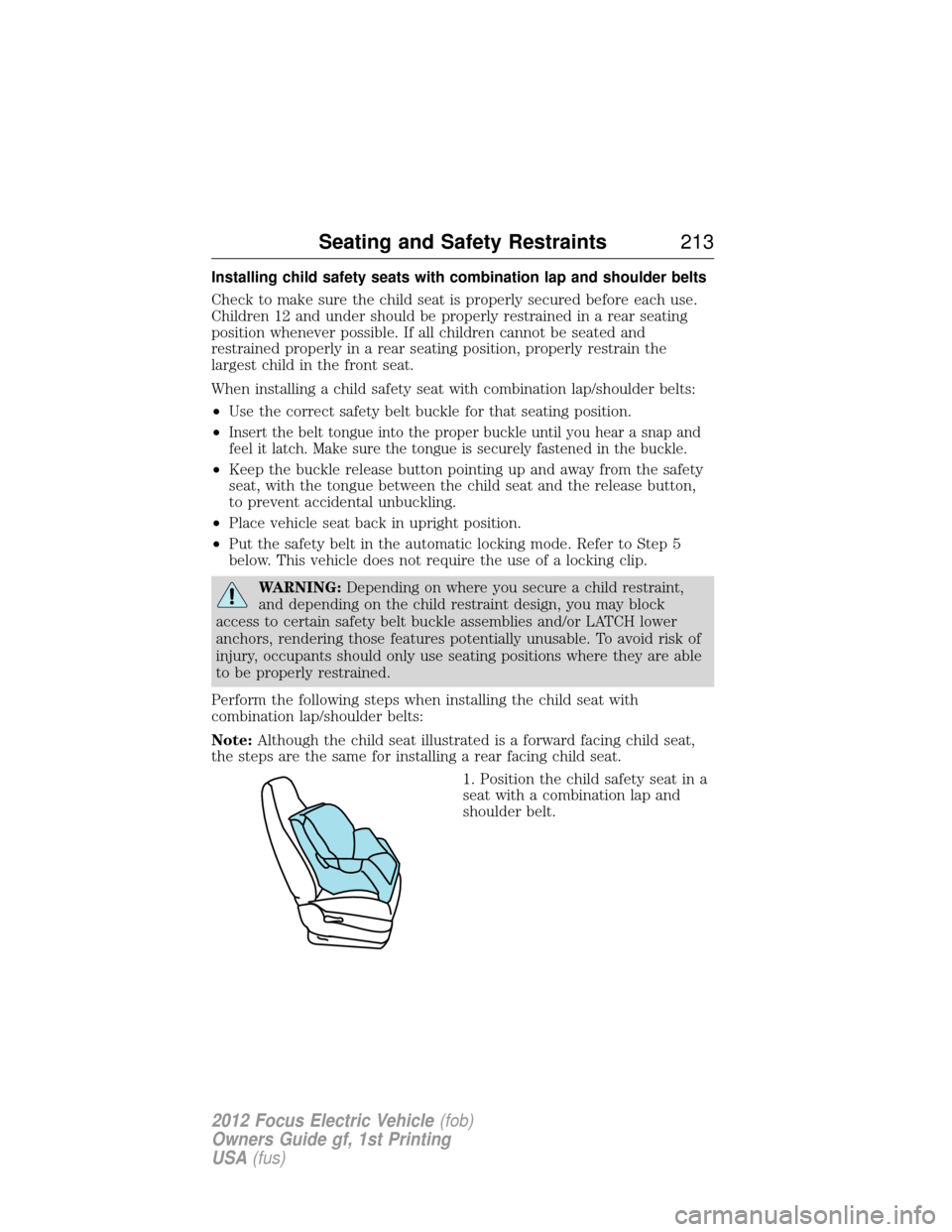
Installing child safety seats with combination lap and shoulder belts
Check to make sure the child seat is properly secured before each use.
Children 12 and under should be properly restrained in a rear seating
position whenever possible. If all children cannot be seated and
restrained properly in a rear seating position, properly restrain the
largest child in the front seat.
When installing a child safety seat with combination lap/shoulder belts:
•Use the correct safety belt buckle for that seating position.
•
Insert the belt tongue into the proper buckle until you hear a snap and
feel it latch. Make sure the tongue is securely fastened in the buckle.
• Keep the buckle release button pointing up and away from the safety
seat, with the tongue between the child seat and the release button,
to prevent accidental unbuckling.
• Place vehicle seat back in upright position.
• Put the safety belt in the automatic locking mode. Refer to Step 5
below. This vehicle does not require the use of a locking clip.
WARNING: Depending on where you secure a child restraint,
and depending on the child restraint design, you may block
access to certain safety belt buckle assemblies and/or LATCH lower
anchors, rendering those features potentially unusable. To avoid risk of
injury, occupants should only use seating positions where they are able
to be properly restrained.
Perform the following steps when installing the child seat with
combination lap/shoulder belts:
Note: Although the child seat illustrated is a forward facing child seat,
the steps are the same for installing a rear facing child seat.
1. Position the child safety seat in a
seat with a combination lap and
shoulder belt.
Seating and Safety Restraints 213
2012 Focus Electric Vehicle(fob)
Owners Guide gf, 1st Printing
USA (fus)